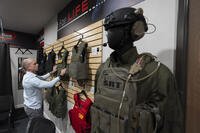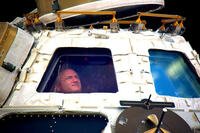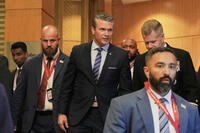Maj. Michael Fick is an instructor at the B-1B Weapons Instructor Course, assigned to the 77th Weapons Squadron at Dyess Air Force Base, Texas. He has been flying the B-1 since 2010 and has had multiple deployments to the Middle East and Pacific regions.
In the B-1 Lancer community, we're used to waging war against our nation's enemies, whether through 17 years of nonstop combat deployments to "the sandbox," as we commonly refer to areas in the Middle East, or our most recent challenge with the novel coronavirus.
The 77th Weapons Squadron at Dyess Air Force Base, Texas, is the B-1 division of the United States Air Force Weapons School and the unit where I currently serve as an instructor. We train and graduate the best B-1 aviators and have done so since 1992. These graduates go on to lead combat and training squadrons to the highest standards, ensuring any aircraft checking into a fight using a B-ONE call sign on the radio is recognized the world over as notification that "something is about to go boom."
Enter our most recent challenge, COVID-19, the insidious virus that is affecting civilian and military populations worldwide. Our particular challenge is to continue training and flying the B-1 here in Abilene, Texas. On the surface, it would appear the B-1 Weapons School is alive and well. If you happened to be in town recently and heard four jets take off with full afterburners, that was our students learning to fly combat missions. These sorties are training to bring 96 2,000-lb. smart bombs to the enemy in a cohesive fighting formation. As a result of planning, practice and expertise, we are able to put those bombs on target within moments.
As combat aviators, we constantly assess and determine levels of risk. How we weigh risk in our current health crisis is important: We cannot just quit training and leave the country without rapid response options should problems arise around the world. Understanding that we will have to put some people in close proximity to others in order to fly, we take precautions to reduce risks to an acceptable level by modifying how we conduct local operations.
The 7th Bomb Wing has adjusted its flying schedule to allow for social distancing within aircrews and aircraft maintainers. Different maintenance squadrons across the base work on the aircraft on different days and shifts, while flight crews stay constrained to their respective squadrons and have separated into "hard crews." A hard crew in the B-1 consists of two pilots and two weapons systems officers, who do not fly with any other crews. Typically, we would trade crew members around so all of them could operate with any other crew. But in this situation, crossing streams could be detrimental to the entire force.
The inside of the B-1 is kind of like sitting with three of your best friends in an area the size of four phone booths. Social distancing and continuous disinfection pose a challenge, considering the number of people and constant use of the aircraft. However, B-1 teams follow the Defense Department and Centers for Disease Control guidelines set forth to minimize the potential spread of the virus inside the aircraft.
When a crew shows up at the aircraft, they wipe down hard surfaces with commercially available disinfectant wipes, and do so again before they leave. This provides a routine protocol for disinfection of surfaces between different crews sitting in the same seat, operating the same stick and throttles, and throwing the same switches. Once we leave our squadron spaces to fly, maintaining the recommended six-foot separation is difficult, so masks and bandanas are being worn to reduce the risk of virus transmission between crew members.
Every base is different, and our leadership has closely monitored the local situation and will adjust operations as necessary to ensure the safety of our team and mission readiness. The crew force is simultaneously worried about the virus and its impact on our local community, our families and our nation. However, we are resilient and are meeting this challenge head on.
Our students are working hard, and we continue to stand ready to work diligently to provide the next batch of world-class weapons officers to the B-1 community and Air Force, worldwide pandemic notwithstanding.
-- The opinions expressed in this op-ed are those of the author and do not necessarily reflect the views of Military.com. If you would like to submit your own commentary, please send your article to opinions@military.com for consideration.















